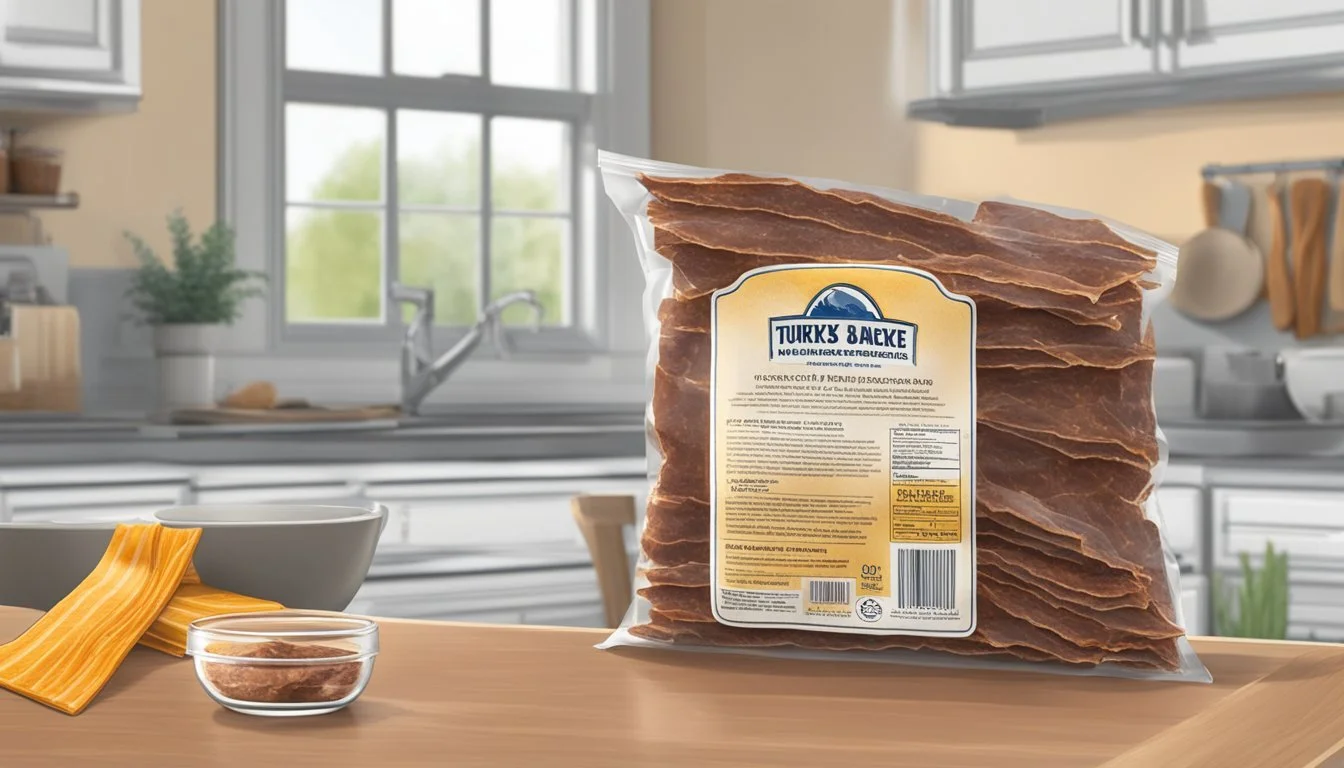Does Turkey Jerky Spoil?
Understanding Shelf Life and Storage
Turkey jerky, like any meat product, can spoil if not stored properly. Yes, turkey jerky can go bad, even though it generally has a more extended shelf life compared to fresh turkey. This longevity primarily comes from the dehydration and curing processes, which inhibit bacterial growth and spoilage.
To ensure the safety and quality of turkey jerky, it should be stored in optimal conditions. Unopened, properly packaged turkey jerky can remain fresh for quite a lengthy period. However, once the packaging is compromised, refrigeration or even freezing becomes essential to extend its shelf life. Improper storage conditions can lead to spoilage, which, if consumed, could pose food safety risks.
Food safety concerning turkey jerky hinges on its preservation methods. Homemade jerky, lacking commercial preservatives, tends to spoil faster than store-bought versions. An observant eye for signs of spoilage and adherence to storage recommendations can help maintain its freshness and edibility, ensuring a safe snacking experience.
Understanding Jerky
Jerky is a popular and convenient dried meat snack known for its extended shelf life and rich flavors. This section explores what turkey jerky is, its nutritional content, and other popular types of jerky.
What Is Turkey Jerky?
Turkey jerky is made from turkey meat that has been sliced into strips, seasoned, and dried. The drying process removes moisture, which helps to preserve the meat and extend its shelf life.
Seasonings and marinades add flavor, and the jerky can be smoked or cured. Turkey jerky is leaner than beef jerky, making it a popular choice for those looking to reduce fat intake.
The Nutritional Value of Jerky
Jerky, including turkey jerky, is a high-protein snack that provides a quick and portable source of nutrition. A typical serving of turkey jerky (28 grams) can contain around 10-15 grams of protein, minimal fat, and low carbohydrates.
However, jerky can be high in sodium due to curing and seasoning processes. It is important to read labels for any preservatives or additives that may affect health. Homemade jerky can offer a healthier alternative with controlled ingredients.
Popular Types of Jerky
Besides turkey, there are several types of jerky available, including beef, pork, and even fish jerky. Beef jerky is the most well-known, offering a variety of flavors and textures.
Premium beef jerky often features high-quality cuts and fewer additives. Pork jerky is another option, known for its bold flavors and tenderness. Fish jerky, though less common, provides a unique taste and is popular among seafood lovers.
Each type of jerky offers different nutritional profiles and flavor experiences, catering to diverse preferences and dietary requirements.
Factors Affecting Jerky Spoilage
The spoilage of turkey jerky is influenced by various factors, including its ingredients and preservation methods, the environment it is stored in, and the type of packaging used. Understanding these elements helps maintain the product's quality and safety.
Ingredients and Preservation Methods
The ingredients and methods used in making turkey jerky greatly impact its shelf life. High-quality cuts of turkey, combined with proper seasoning and curing agents like salt and nitrates, help inhibit bacterial growth.
Ingredients like salt draw moisture out of the meat, reducing the chances of bacterial growth. Preservatives and antioxidants can further extend shelf life by slowing down oxidation and spoilage processes.
Environmental Factors
Environmental conditions such as temperature, humidity, and exposure to sunlight significantly affect turkey jerky's spoilage.
Temperature: High temperatures accelerate spoilage by promoting bacterial growth. It's best to store jerky in a cool, dry place.
Humidity: Moisture in the air can penetrate the jerky, leading to mold and bacterial contamination.
Sunlight: Direct exposure to sunlight can cause the fats in turkey jerky to become rancid and speeds up oxidation.
Packaging and Exposure to Air
Proper packaging is crucial for maintaining the freshness of turkey jerky.
Vacuum-Sealed Packaging: Removes air, reducing the risk of spoilage by limiting the oxygen available for bacterial growth.
Airtight Containers: Also help by keeping out moisture and contaminants. Once opened, turkey jerky should be consumed quickly or stored in an airtight container to prolong its shelf life.
Oxygen Exposure: Oxygen can cause the fats in jerky to oxidize, leading to rancidity. Foods that are vacuum-sealed or stored in airtight containers are less likely to spoil quickly.
Adhering to these storage practices and using effective preservation methods ensures that turkey jerky remains safe and enjoyable for a longer period.
Proper Storage for Extending Shelf Life
Proper storage techniques can significantly extend the shelf life of turkey jerky. Key practices include maintaining an appropriate temperature, ensuring a dry environment, and using suitable containers for storage.
At Room Temperature
Turkey jerky can be stored at room temperature but should be kept in an airtight container to prevent exposure to moisture and air. This helps to maintain its dryness and prolong freshness.
A pantry or cupboard is a suitable storage environment, provided it remains cool and dry. Keeping jerky in a well-ventilated area that avoids direct sunlight can further reduce the risk of spoilage.
Refrigeration and Freezing
Refrigeration can extend the shelf life of turkey jerky by 1-2 months when it remains unopened. Once the package is opened, consuming it within a few weeks is advisable.
For even longer storage, freezing jerky is highly effective. Vacuum-sealed bags or airtight containers can be used to prevent freezer burn and maintain jerky's quality for several months. Labeling with the date ensures the jerky is used within a reasonable period.
Dark and Cool Conditions
A dark and cool environment is ideal for storing turkey jerky. Light can degrade the quality of the meat over time, so using opaque containers or storage locations that do not receive light is beneficial.
The temperature should also be consistently cool to avoid creating conditions where bacteria can thrive. Ensuring these conditions can maximize the shelf life and maintain the flavor and texture of turkey jerky.
Identifying Spoiled Jerky
When determining if turkey jerky has gone bad, it's crucial to examine various factors including appearance, odor, flavor, and texture. Each aspect can provide clear warning signs of spoilage.
Visual Indicators of Spoilage
One of the first signs of spoiled jerky is changes in its appearance. Discoloration is a major indicator; turkey jerky that turns an unusual shade of gray or green may be heading towards spoilage.
Visible mold growth is another clear signal. Mold spores, often appearing as white or green fuzzy spots, necessitate immediate disposal of the product. Keep an eye out for darkening or fading that deviates significantly from its original color.
Changes in Smell and Taste
Odor shifts are also telling. Fresh turkey jerky usually has a mild, smoky aroma. If it starts emitting a rancid or sour smell, it's time to discard it. A strong off-putting odor can indicate bacterial growth and potential food poisoning risks.
Taste changes might not be immediately evident. However, any sour, bitter, or off-flavor is a warning sign of spoilage. It's safer to rely on smell before taking a bite.
Texture and Mold Growth
Changes in texture are equally important. Fresh jerky typically has a firm, dry, yet slightly pliable texture. If the jerky becomes slimy or sticky, it has likely spoiled.
Mold growth is an unmistakable sign. Even a small patch of mold requires the entire batch to be thrown away, as it can spread unseen. Always prefer to store jerky in a controlled environment to prevent unnecessary microbial growth.
When examining turkey jerky, trust your senses to detect any signs of spoilage and avoid consuming if any indicators of spoilage are present.
Health Considerations When Consuming Jerky
Jerky can be a convenient and protein-rich snack. It's important to be aware of the potential health risks and safe consumption practices to avoid foodborne illnesses.
Foodborne Illness Risks
Consuming jerky that has spoiled can pose serious health risks. Bacteria such as Salmonella and E. coli can contaminate jerky, leading to foodborne illness. Symptoms may include nausea, vomiting, diarrhea, and abdominal pain.
The risk of microbial growth increases if jerky is not stored properly. High humidity, warm temperatures, and improper packaging can create an environment conducive to bacterial proliferation. As a dried meat product, jerky must be cured and preserved correctly to remain safe to eat.
Warning signs of spoiled jerky include an off smell, unusual texture, and discoloration. It's crucial to pay attention to these signs to prevent potential health risks.
Safe Consumption Guidelines
To ensure jerky is safe to consume, follow these guidelines. Store jerky in a cool, dry place and ensure it remains tightly sealed when not in use. Refrigeration can extend its shelf life and further reduce the risk of contamination.
Look for jerky that uses minimal preservatives and opt for products labeled as low-sodium and free of added sugars. This reduces the intake of potentially harmful additives which can impact health.
When consuming homemade jerky, ensure that it has been properly cured and dried. Use a reliable meat thermometer to confirm that the internal temperature has reached a safe level to kill harmful bacteria. Practicing good hygiene during its preparation and storage is also essential to minimize health risks.
Best Practices in Handling and Consumption
Ensuring the longevity and safety of turkey jerky involves proper handling and storage. Implementing the right techniques for opening, resealing, and maximizing freshness can significantly extend the shelf life of your jerky.
Proper Opening and Resealing Techniques
Opening turkey jerky properly helps maintain its quality. Use clean hands or gloves to prevent contamination. This minimizes bacterial growth, ensuring the jerky remains safe to consume.
After opening, use airtight containers or resealable bags to store the jerky. These methods reduce air exposure, which can cause the jerky to become stale or spoil. For added protection, consider vacuum-sealed bags which remove most of the air, extending freshness.
Properly label the packaging with the date of opening. This practice helps monitor the shelf life and manage consumption. Avoid exposing the jerky to sunlight or extreme temperatures, as these conditions can accelerate spoilage.
Maximizing Freshness After Opening
After turkey jerky is opened, refrigeration is key to maximizing its freshness. Store the jerky in a refrigerator at temperatures between 35-38°F (1.7-3.3°C). This helps slow bacterial growth and preserve moisture content.
If refrigeration is not an option, keep the jerky in a cool, dry place away from sunlight and heat sources. Ensure the storage area is free from excess moisture to prevent mold growth.
For long-term preservation, freezing turkey jerky is effective. When properly packaged, frozen jerky can retain its quality for up to 6 months. Use vacuum-sealed or airtight containers to prevent freezer burn and unwanted odor absorption.
Additionally, check the jerky regularly for signs of spoilage, such as off odors or unusual texture changes, to ensure it remains safe to eat.
Lifespan of Turkey Jerky
The lifespan of turkey jerky varies based on how it is stored and whether it is opened or unopened. Unopened and properly stored turkey jerky can last up to 12 months. Packaging plays a vital role here, as airtight containers prevent moisture from compromising the jerky.
Opened turkey jerky should be consumed within a few weeks to maintain its freshness. Proper storage, such as using resealable bags or airtight containers, can extend its shelf life to about 1-2 months.
Homemade beef jerky and homemade turkey jerky typically have a shorter shelf life. When stored properly, they can last for 1-2 months. These homemade versions lack the preservatives found in commercial jerky, making them more susceptible to spoilage.
Here’s a quick reference:
Jerky Type Shelf Life (Unopened) Shelf Life (Opened) Commercial Turkey Jerky Up to 12 months 1-2 months Homemade Turkey Jerky 1-2 months A few weeks
Temperature and light also impact turkey jerky's lifespan. Keeping jerky in a cool, dark place can help extend its shelf life. Refrigeration is optional for unopened jerky but recommended for opened packages, especially in hot and humid environments.
Expiration dates on commercial turkey jerky packages are useful indicators. Consuming jerky past its expiration date can compromise quality and safety. Always check for signs of spoilage, like off smells or mold, before eating.
Fresh jerky retains its taste and texture when stored appropriately. Ensuring optimal conditions helps maintain its flavor and safety for as long as possible.
When to Discard Turkey Jerky
Turkey jerky, like all meat products, has a finite shelf life. There are specific signs to watch for that indicate it is time to discard the jerky.
Signs of Spoilage
Smell: Spoiled turkey jerky may emit an off or rancid odor.
Texture: If it becomes sticky, slimy, or overly hard, discard it.
Color: Changes in color, particularly dark spots or mold, signal spoilage.
Quality Factors
Fats in the jerky can go rancid over time. Rancid fats have an unpleasant taste and smell, affecting the quality of the jerky.
Dehydration plays a key role. Properly dehydrated jerky lasts longer, but moisture can lead to mold growth.
Health Risks
Consuming spoiled jerky poses health risks such as food poisoning. Symptoms include nausea, vomiting, diarrhea, and abdominal pain.
Storage Conditions
For best results, turkey jerky should be kept in a cool, dry place. Mahogany Smoked Meats and other high-quality brands may have specific storage instructions on the packaging.
Expiration Date
While jerky can sometimes last past its "best-by" date if stored well, it’s generally safer to adhere to the expiration date. If there’s any doubt about its freshness, it’s prudent to discard the product.
By staying aware of these factors, you can ensure turkey jerky remains safe to eat and retains its quality.









